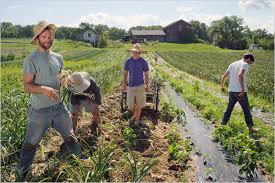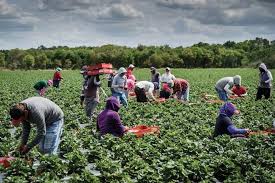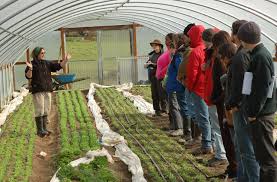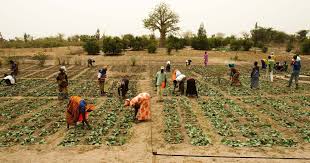Agriculture in employment generation is a vital aspect of many economies, particularly in developing countries where a significant portion of the population relies on farming for their livelihood.
Beyond food production, agriculture serves as a crucial source of jobs, offering opportunities not only to farmers but also to those engaged in various sectors of the agricultural supply chain, including processing, distribution, and retail.
The sector’s capacity to absorb a large workforce highlights its importance in driving economic development and alleviating poverty.
In rural areas, agriculture often stands as the primary means of employment, sustaining families and communities. With a growing global population and increasing demand for food, the agricultural sector faces opportunities for expansion and innovation, leading to diverse job creation.
These opportunities range from traditional farming roles to modern practices such as precision farming and sustainable agriculture.
Moreover, agriculture generates jobs in related sectors, such as agro-processing, logistics, and marketing. As agricultural output rises, the need for support services grows, resulting in job creation in equipment manufacturing, transportation, and agricultural consultancy.
This interconnectedness underscores how robust agricultural growth can stimulate broader economic activity and employment opportunities.
Agriculture plays an essential role in providing employment, particularly in developing regions. By promoting agricultural development, nations can enhance food security, improve livelihoods, and foster sustainable economic growth.
Acknowledging the significance of agriculture in employment generation is crucial for policymakers aiming to develop strategies that support this vital sector and tackle the challenges it faces in an ever-evolving global landscape.
Historical Context of Agricultural Employment

Agricultural employment has deep roots in human history, tracing back to the dawn of civilization. Early human societies were primarily hunter-gatherers, relying on the natural environment for sustenance.
The transition to agriculture, known as the Neolithic Revolution, marked a pivotal moment around 10,000 years ago when communities began to domesticate plants and animals.
This shift allowed for more stable food supplies, leading to population growth and the establishment of permanent settlements. As farming practices evolved, so did the nature of agricultural employment, shaping social structures and economic systems.
In ancient civilizations, agriculture was the backbone of economies, employing vast numbers of people. For instance, in ancient Egypt, a large workforce was required for the cultivation of crops along the Nile River.
Similarly, the Roman Empire relied heavily on agriculture, with a significant portion of its population engaged in farming. The reliance on agrarian labor during these periods established agriculture as a dominant form of employment, influencing trade, wealth distribution, and societal hierarchy.
The Middle Ages saw a continuation of agricultural employment as feudal systems emerged. Serfs and peasants worked the land in exchange for protection and a share of the harvest. This relationship defined social classes and economic stability in many regions.
With the onset of the Agricultural Revolution in the 18th century, significant advancements in farming techniques, such as crop rotation and selective breeding, led to increased productivity. This period also saw the beginning of rural-to-urban migration as people sought employment in emerging industrial sectors.
The 20th century brought further transformation through mechanization and technological innovations.
Tractors and other machinery reduced the need for manual labor, leading to a decline in agricultural employment in developed countries. However, this also created new opportunities in agribusiness, food processing, and agricultural technology sectors.
Today, agriculture remains a critical source of employment, especially in developing nations, where it continues to support livelihoods and drive economic growth.
The historical context of agricultural employment reflects its adaptability and resilience, highlighting its enduring significance in shaping human society and the economy.
Understanding this history is essential for addressing contemporary challenges in the agricultural sector and promoting sustainable development.
The Current State of Agricultural Employment
The agricultural sector plays a significant role in the economy and employment. Here are the key aspects of the current state of agricultural employment:
1. Employment Statistics: Agriculture employs a large percentage of the global workforce, particularly in developing countries, where it can account for up to 60% of total employment.
2. Economic Contribution: The agricultural sector contributes significantly to the GDP of many countries, driving economic growth and stability.
3. Changing Dynamics: The nature of agricultural employment is evolving, with more people moving from traditional farming roles to various jobs within the agricultural value chain.
4. Urbanization Impact: Urbanization is reshaping agricultural employment, as more individuals seek opportunities in urban areas, leading to labor shortages in rural regions.
5. Importance of Sustainable Practices: There is a growing emphasis on sustainable agricultural practices, which can create new job opportunities in areas like organic farming and conservation.
Read Also: Tangerine and Mandarin Trunk: Economic Importance, Uses and By-Products
Key Sectors Within Agriculture That Create Jobs

Several sectors within agriculture create diverse job opportunities. Here are some of the key sectors:
1. Crop Production: This sector involves planting, cultivating, and harvesting crops. Jobs range from farm laborers to agronomists and farm managers.
2. Livestock Farming: Raising animals for food, fiber, and other products creates employment in areas like breeding, feeding, and veterinary care.
3. Agricultural Research and Development: This sector focuses on innovations and improvements in farming practices, requiring researchers, scientists, and technicians.
4. Food Processing and Manufacturing: Jobs in this sector include processing raw agricultural products into consumable goods, creating opportunities in factories and distribution.
5. Agricultural Services: This sector provides essential support services such as pest control, soil management, and equipment maintenance, employing various professionals.
The Role of Women in Agricultural Employment
Women play a crucial role in agricultural employment and contribute significantly to food production and rural development. Here are some key points regarding their role:
1. Workforce Participation: Women comprise a significant portion of the agricultural workforce, often engaging in various tasks, from planting to processing.
2. Leadership and Management: Increasingly, women are taking on leadership roles in agriculture, managing farms and agribusinesses and contributing to decision-making processes.
3. Access to Resources: Despite their contributions, women often face challenges in accessing resources such as land, credit, and training, limiting their potential.
4. Empowerment Initiatives: Various programs and initiatives aim to empower women in agriculture, providing training, resources, and support to enhance their productivity.
5. Sustainable Practices: Women are often at the forefront of implementing sustainable agricultural practices, focusing on conservation and food security.
Youth Engagement in Agriculture
Engaging youth in agriculture is essential for the sector’s future sustainability and growth. Here are some important aspects of youth engagement:
1. Employment Opportunities: Agriculture offers diverse career paths for young people, from traditional farming to roles in research, technology, and entrepreneurship.
2. Innovation and Technology: Young people are often more open to adopting new technologies and innovative practices, driving efficiency and productivity in agriculture.
3. Education and Training: Providing education and vocational training in agriculture can attract youth and equip them with the skills needed for the industry.
4. Entrepreneurship: Encouraging youth to start their own agricultural ventures fosters innovation and contributes to economic growth.
5. Community Involvement: Engaging youth in community agriculture projects fosters a sense of responsibility and connection to the land and food systems.
Technological Advancements and Job Creation
Technological advancements are transforming the agricultural landscape, impacting employment opportunities in various ways. Here are some key points about technology and job creation:
1. Automation and Robotics: While automation may reduce some traditional farming jobs, it also creates new roles in technology maintenance, programming, and support.
2. Data Analytics: The rise of data-driven agriculture requires professionals skilled in data analysis, helping farmers make informed decisions based on analytics.
3. Precision Agriculture: Technology such as drones, sensors, and GPS allows for more efficient farming practices, creating jobs in tech support and field analysis.
4. E-commerce Platforms: Online marketplaces enable farmers to sell their products directly to consumers, creating jobs in logistics, marketing, and sales.
5. Training and Education: As technology advances, there is a growing need for training programs to equip the workforce with necessary skills, leading to new teaching and support roles.
Challenges Facing Agricultural Employment
Agricultural employment faces numerous challenges that affect job generation and workforce stability. Here are the main challenges:
1. Labor Shortages: Many agricultural sectors are experiencing labor shortages, particularly in rural areas where younger generations are migrating to cities for better opportunities.
2. Seasonal Employment: Agriculture often relies on seasonal labor, leading to unstable employment and income for workers, making it difficult for them to plan financially.
3. Low Wages: Many agricultural jobs offer low wages, which can deter individuals from seeking work in the sector and lead to high turnover rates.
4. Working Conditions: Poor working conditions, including long hours and exposure to hazardous environments, can discourage potential workers from joining the agricultural workforce.
5. Climate Change: The impacts of climate change can create uncertainties in agricultural production, affecting job security and income for workers in the sector.
Agricultural Policies and Their Effect on Job Generation
Agricultural policies play a crucial role in shaping employment opportunities within the sector. Here are some key points regarding the effects of policies on job generation:
1. Support Programs: Government support programs, such as subsidies and grants, can encourage job creation by providing financial assistance to farmers and agribusinesses.
2. Trade Policies: Trade agreements can impact job generation by opening new markets for agricultural products or limiting access to international markets.
3. Labor Regulations: Policies governing labor rights and protections can affect the attractiveness of agricultural jobs, influencing workforce participation.
4. Research Funding: Investment in agricultural research and development can lead to innovations that create new job opportunities and enhance productivity.
5. Education and Training Initiatives: Policies that promote education and training in agriculture can equip workers with necessary skills, improving employability and job generation.
Read Also : Phosphorus Content of Soils and Factors Influencing Phosphorus Availability in the Soil
The Role of Education and Training in Agriculture

Education and training are essential for improving agricultural employment and addressing challenges in the sector. Here are some significant aspects of education and training:
1. Skills Development: Providing vocational training and education in agricultural practices can equip workers with valuable skills, enhancing job readiness.
2. Technology Adoption: Training programs focused on new technologies, such as precision farming and data analytics, can help workers adapt to modern agricultural practices.
3. Entrepreneurship Training: Education that encourages entrepreneurial thinking can help individuals start their own agricultural ventures, contributing to job creation.
4. Lifelong Learning: Promoting continuous education and skill development allows workers to keep up with industry changes and advancements, enhancing career prospects.
5. Community Engagement: Educational initiatives that involve community participation can foster a sense of belonging and responsibility among workers, improving job satisfaction.
Sustainable Agriculture and Its Employment Opportunities
Sustainable agriculture offers various employment opportunities while addressing environmental and social challenges. Here are some key points about sustainable agriculture and job creation:
1. Organic Farming: The growing demand for organic products creates job opportunities in organic farming, processing, and marketing.
2. Conservation Practices: Sustainable practices like agroforestry and permaculture can create new roles in land management and conservation efforts.
3. Local Food Systems: Emphasizing local food production and distribution can create jobs in community-supported agriculture (CSA) programs and farmers’ markets.
4. Green Technologies: The adoption of environmentally friendly technologies, such as renewable energy and waste management systems, can lead to new employment opportunities.
5. Education and Outreach: Programs promoting sustainable agriculture practices often require educators and outreach workers, creating additional job opportunities.
The Future of Work in Agriculture
The future of work in agriculture will likely be shaped by several trends and developments. Here are some anticipated changes:
1. Technological Advancements: Continued advancements in technology will create new roles and opportunities, emphasizing the need for a skilled workforce.
2. Automation: While automation may displace some traditional jobs, it can also create demand for skilled workers who can manage and maintain automated systems.
3. Focus on Sustainability: The shift towards sustainable practices will drive job creation in areas like organic farming, conservation, and sustainable resource management.
4. Education and Training Evolution: The future of agricultural employment will depend on evolving education and training programs that meet the demands of a changing industry.
5. Globalization: The global nature of agriculture will continue to influence job opportunities, requiring workers to adapt to international markets and practices.
Do you have any questions, suggestions, or contributions? If so, please feel free to use the comment box below to share your thoughts. We also encourage you to kindly share this information with others who might benefit from it. Since we can’t reach everyone at once, we truly appreciate your help in spreading the word. Thank you so much for your support and for sharing!
Read Also : Ways To Generate Income From Chemical Wastes

